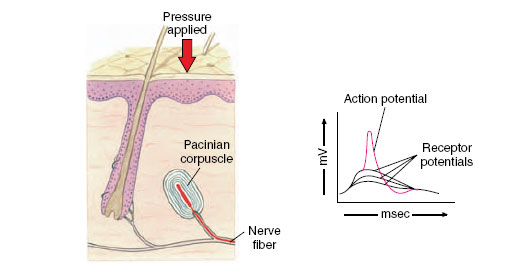Touch
Touch
The pacinian corpuscle, a relatively large mechanoreceptor that registers deep touch and pressure in mammalian skin, illustrates the general properties of mechanoreceptors. These corpuscles are common in deep layers of skin, connective tissue surrounding muscles and tendons, and the abdominal mesenteries. Each corpuscle consists of a nerve terminus surrounded by a capsule of numerous, concentric, onionlike layers of connective tissue (Figure 35-21). Pressure at any point on the capsule distorts the nerve ending, producing a graded receptor potential, a local flow of electric current. Progressively stronger stimuli lead to correspondingly stronger receptor potentials until a threshold current is produced; this current initiates an action potential in the sensory nerve fiber. Stronger stimuli will produce a burst of action potentials. However, if the pressure is sustained, the corpuscle quickly adjusts to the new shape and no longer responds. This response is called adaptation (not to be confused with the evolutionary meaning of this term) and is characteristic of many touch receptors, which are admirably suited to detecting a sudden mechanical change but readily adapt to new conditions. We are aware of new pressures when we put on our shoes in the morning, but we are glad not to be reminded of these pressures all day.
Invertebrates, especially insects, have many kinds of receptors sensitive to touch. Such receptors are well endowed with tactile hairs sensitive to both touch and vibrations. Superficial touch receptors of vertebrates are distributed over the body but tend to be concentrated in areas especially important for exploring and interpreting the environment. In most vertebrates these areas are the face and extremities of limbs. Of the more than half-million separate touch-sensitive spots on the surface of the human body, most are found on the lips, tongue, and fingertips as might be expected based on the large portion of sensory cortex which receives information from these regions (Figure 35-15). The simplest touch receptors are bare nerve-fiber terminals found in skin, but there is an assortment of other kinds of receptors of varying shapes and sizes. Each hair follicle is crowded with receptors that are sensitive to touch.
The pacinian corpuscle, a relatively large mechanoreceptor that registers deep touch and pressure in mammalian skin, illustrates the general properties of mechanoreceptors. These corpuscles are common in deep layers of skin, connective tissue surrounding muscles and tendons, and the abdominal mesenteries. Each corpuscle consists of a nerve terminus surrounded by a capsule of numerous, concentric, onionlike layers of connective tissue (Figure 35-21). Pressure at any point on the capsule distorts the nerve ending, producing a graded receptor potential, a local flow of electric current. Progressively stronger stimuli lead to correspondingly stronger receptor potentials until a threshold current is produced; this current initiates an action potential in the sensory nerve fiber. Stronger stimuli will produce a burst of action potentials. However, if the pressure is sustained, the corpuscle quickly adjusts to the new shape and no longer responds. This response is called adaptation (not to be confused with the evolutionary meaning of this term) and is characteristic of many touch receptors, which are admirably suited to detecting a sudden mechanical change but readily adapt to new conditions. We are aware of new pressures when we put on our shoes in the morning, but we are glad not to be reminded of these pressures all day.
 |
| Figure 35-21 Response of pacinian corpuscle to applied pressure. Progressively stronger pressure produces stronger receptor potentials. When the threshold stimulus is reached, an all-or-none action potential is generated in the afferent nerve fiber. |
Invertebrates, especially insects, have many kinds of receptors sensitive to touch. Such receptors are well endowed with tactile hairs sensitive to both touch and vibrations. Superficial touch receptors of vertebrates are distributed over the body but tend to be concentrated in areas especially important for exploring and interpreting the environment. In most vertebrates these areas are the face and extremities of limbs. Of the more than half-million separate touch-sensitive spots on the surface of the human body, most are found on the lips, tongue, and fingertips as might be expected based on the large portion of sensory cortex which receives information from these regions (Figure 35-15). The simplest touch receptors are bare nerve-fiber terminals found in skin, but there is an assortment of other kinds of receptors of varying shapes and sizes. Each hair follicle is crowded with receptors that are sensitive to touch.




